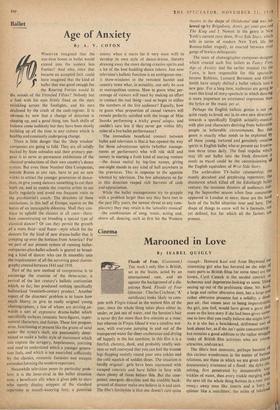Cinema
Marooned in Love
By ISABEL QUIGLY
Floods of Fear. (Gaumont.) THE week's only film is British, set in the States, acted by an international cast, and set against the background of a dis- astrous flood. Floods of Fear (director : Charles Crichton; 'A' certificate) looks likely to com- pete with Virgin Island as the wettest film of the year, since the whole thing takes place either in, under, or just out of water, and the heroine's hair is never dry for more than five minutes at a time; but whereas in Virgin Island it was a carefree wet- ness, with everyone jumping in and out of the transparent water for sheer exuberance and drying off happily in the hot sunshine, in this film it is a fearful, clammy, dank, and probably smelly wet- ness so well conveyed that you can feel the trouser legs flapping moistly round your own ankles and the cold squelch of sodden shoes. The situation is hardly original: girls have been marooned with escaped convicts and have fallen in love with them plenty of times before this. But the com- petent, energetic direction and the credible back- ground of disaster make one believe in it and care. The film's limitation is that one doesn't care quite
•
enough: Howard Keel and Anne Heywood interesting girl who has hovered on the edge of main parts in British films for some time) arc the lovers, Cyril Cusack is the second convict, as lecherous and degenerate-looking as some Thing oozing up out of the prehistoric slime. M r. a large and rather obtrusive man, has a large and rather obtrusive presence but a solidity, a dead' pan air, that comes near to being impenetrable; the girl, you feel, would have given a great deal more to the love story if she had been given some' one to love that you really believe she might love' As it is she has a bewildered, driftwood sort of look about her, as if she isn't quite concentrating: but remains a good addition to the rather straggly ranks of British -film actresses who are young' attractive, and can act. The film's best moments, perhaps because of this curious woodenness in the matter of human relations, are those in which we are given almost documentary treatment of a flood: the dyke cli5‘ solving, first penetrated by innumerable tiny trickles of water, then every trickle merging with the next till the whole thing flattens in a roar that sweers away men like insects and a lorry to splinter like a matchbox; the miles of Lakeland
with chimneys and trees and telegraph poles, often seen but not with such a sense of desolation; the faces of the refugees lining up for parcels of cloth- ing. Only at one moment was I conscious of the studio magician : when the house where the con- victs and girl are sheltering collapses under the weight of water, and roof, chimneys, windows and staircase went flying through the air and floating away with a neat, swift crunching that inevitably brought to mind (whether rightly or wrongly) some neat little wooden models blown sky-high in the studio tank.















































































 Previous page
Previous page